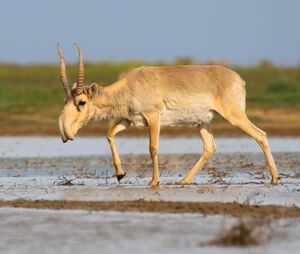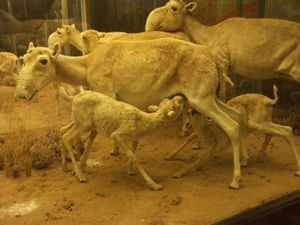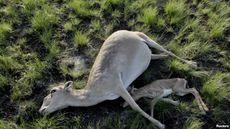ظبي سايگا
| سايگا Saiga | |
|---|---|

| |
| ذكر سايگا في ملاذ ستپنوي الطبيعي، أوبلاست أستراخان، روسيا. | |

| |
| أنثى سايگا في محمية أسكانيا-نوڤ الحيوية، رايون كاخوڤكا، أوكرانيا. | |
| التصنيف العلمي | |
| مملكة: | |
| Phylum: | |
| Class: | |
| Order: | |
| Family: | |
| Subfamily: | |
| Genus: | سايگا
|
| Species: | س. التتري
|
| Binomial name | |
| السايگا التتري | |
| تحت الأنواع | |
| |

| |
| إعادة إنشاء نطاق انتشار السايگا (الأبيض) ونطاق الانتشار الحالي للسايگا التتاري (بالأخضر) والسايگا المنغولي (بالأحمر). | |
| Synonyms[2] | |
|
List
| |
السايگا (saiga الاسم العلمي Saiga tatarica)، هو نوع من الظباء معرضة لخطر الانقراض الماحق وكانت تستوطن السهول الأوراسية الواسعة من سفوح الجبال الكرپاتية والقوقاز وحتى جونگاريا ومنغوليا، كما عاشت في قارة أمريكا الشمالية خلال عصر الپلستوسين. أما الآن فلم يعد يوجد تحت نوعه الأساسي - السايگا التتري - إلا في موقع واحد بروسيا (في سهول شمال غرب منطقة القرم) وثلاث مناطق بكازاخستان (جبال الأورال والأوستيورت وصحراء دالا بيتباك)، كما تهاجر بعض الحيوانات من هذه المناطق جنوباً إلى أوزباكستان وأحياناً - خلال الشتاء - تركمانستان. إلا أنه بات منقرضاً الآن في الصين وجنوب غرب منغوليا. وأما تحت نوع السايگا المنغولي فهو لا يقطن سوى غرب منغوليا.[3]
الخصائص البدنية

يتراوح طول السايگا بين 0.6–0.8 م حتى الكتفين ويتراوح وزنه بين 36-63 كگ. الذكور ذات القرون تكون أكبر حجماً عن الإناث التي لا تمتلك قروناً. تعيش لفترات تصل إلى 6-10 سنوات.
الموئل والسلوك
تعيش ظباء السايگا في قطعان كبيرة ترعى في المناطق الشبه صحراوية، السهول والمراعي وربما الغابات المفتوحة حيث تقتات مختلف أنواع النباتات، وبعضها يعتبر ساماً للحيوانات الأخرى. يمكنها عبور مسافات طويلة والسباحة عبر النهر، لكنها تتجنب المناطق الوعرة وشديدة الإنحدار. يبدأ موسم التزواج في نوفمبر، عندما يشتعل القتال بين الذكور من أجل الحصول على الإناث. يفوز الفائز بقطيع يتراوح من خمسة إلى 50 أنثى. في الربيع، تضع الأمهات صغيرين (في ثلثي الحالات) أو صغير واحد.
الانتشار
أثناء العصر الجليدي كانت ظباء سايگا تعيش في أنحاء واسعة، تمتد من الجزر البريطانية غرباً مروراً بوسط آسيا وشرقاً حتى مضيق برنگ إلى ألاسكا وأخيراً إقليم يوكون. وقد كانت حيوانات تميِز إقليم سيثيا خلال العصور القديمة، وبناءً على وصف المؤرخ سترابو لحيوان سماه "الكولوس" كان "حجمه بين حجم الغزال والخروف"، وقد كان يُظن خطأ آنذاك أنه يشرب المياه من أنفه.[4] في بداية القرن الثامن عشر كانت ظباء سايگا لا تزال تقطن سواحل البحر الأسود وجبال كارپات، بالإضافة إلى التخوم الشمالية للقوقاز وحتى جونغاريا ومنغوليا.
وبعد انحدار سريع في أعداد هذه الحيوانات وصلت إلى حافة الانقراض في العشرينيات، إلا أنها تمكنت من التعافي، وقد كان يقطن مليونا رأس منها سهوب أوراسيا بحلول عام 1950.
إلا أن أعدادها عادت للتراجع السريع عقب انهيار الاتحاد السوڤيتي، نتيجة للصيد غير القانوني والحاجة لقرونها للاستعمال في الطب الصيني. وعند نقطة ما حاول بعض جمعيات حماية البيئة - مثل الصندوق العالمي للطبيعة - تشجيع صيادة السايغا بديلاً للقرون التي كانت تُصَطاد لأجلها الكركدنيات.[5]
الحفاظ
في الوقت الحاضر تواجه ظباء سايگا تواجه مرة أخرى تقلصاً هائلاً في أعدادها، فيقدر أن 95% منها اختفت خلال 15 عاماً،[6] يصنفها الآن الاتحاد العالمي للحفاظ على الطبيعة كنوع معرض للخطر الماحق. يقدر ما تبقى منها اليوم بنحو 50.000 رأس، تتوزع على منقطة كالميكيا وثلاث مناطق في كازاخستان وومنطقتين معزولتين بمنغوليا، كما لا زالت توجد مجموعة صغيرة منها في منطقة القرم بروسيا تحت تهديدٍ كبير.[7]
لكن في شهر مايو عام 2010 توفي ما يقدر بقرابة 12,000 ظبي سايگا في منطقة الأورال بقزاخستان من أصل النحو 26,000 رأساً التي كانت تقطنها. وتُعزَى هذه الوفيات حالياً إلى داء باستيريلا الطيور (en)، وهو مرض معد يصيب الرئة والأمعاء، ولا زال سبب انتشاره في المنطقة غير معروف.[8] أعادت كازاخستان في شهر نوفمبر عام 2010 سنَّ قانون يمنع صيد السايغا، مدَّدته حتى عام 2021، في محاولةٍ لإنقاذ النوع من الانقراض.[9]
في مايو 2015، صرح مسئول قزخي رفيع المستوى في مجال الفضاء، بأن هناك شكوك حول ارتباط وفاة أعداد ضخمة من ظباء السايگ، 90.000 ظبي، بتحطم صاروخ روسي، لكن نائب رئيس وكالة الفضاء القزخية، لم يؤكد هذا الكلام بشكل قاطع.[10]
وكان الأمر قد أعلن أثناء جلسة اللجنة البرلمانية في أستانا، المنعقدة في 26 مايو 2015، عن وفاة 90.000 من ظباء السايگا في كوستاناي، أقمولا، قزخستان، وأن سبب وفاة هذه الظباء مرتبط بالبيئة، ومرتبط كذلك بمركز بايكونور الفضائي.
في يونيو 2025 بدأت أعداد ظباء السايگا في الارتفاع بشكل كبير في قزخستان لتصل إلى ما يقارب 4 مليون ظبي، لكن المزارعين يعانون بسبب تنافس هذه الظباء على المراعي. في غضون ذلك، تسبب تغير المناخ في انتشار الجراد والخنافس، وحتى العناكب السامة، مما يهدد المحاصيل والمنازل.[11] ويرجع ازدياد أعداد ظباء السايگا في قزخستان إلى انخفاض عدد عمليات إطلاق المركبات الفضائية من بايكونور بشكل كبير، مما يعني أن إطلاق الوقود السام، الهپتيل، الذي عانت منه السايگا والبشر على حد سواء، قد انخفض.
المصادر
- ^ أ ب IUCN SSC Antelope Specialist Group (2018). "Saiga tatarica". IUCN Red List of Threatened Species. 2018: e.T19832A50194357. doi:10.2305/IUCN.UK.2018-2.RLTS.T19832A50194357.en. Retrieved 24 January 2022.
- ^ Sokolov, V.E. (1974). "Saiga tatarica" (PDF). Mammalian Species (38): 1–4. doi:10.2307/3503906. JSTOR 3503906. Archived from the original (PDF) on 4 March 2016.
- ^ "Saiga/mongolian Saiga (Saiga tatarica)". Evolutionarily Distinct and Globally Endangered. The Zoological Society of London. Retrieved 19 December 2012.
- ^ Strabo (25 September 2012). "Book VII, Chapter 4, Paragraph 8". Geography. Retrieved 19 December 2012.
- ^ Ellis, Richard (2004). No Turning Back: The Life and Death of Animal Species. New York: Harper Perennial. p. 210. ISBN 0-06-055804-0. Retrieved 19 December 2012.
- ^ "Welcome to the Saiga Conservation Alliance". Saiga Conservation Alliance. Retrieved 19 December 2012.
- ^ "Emergency appeal: saigas of the pre-Caspian region of Russia under extreme threat". Saiga Conservation Alliance. 18 March 2010. Retrieved 19 December 2012.
- ^ "Mystery over mass antelope deaths in Kazakhstan". BBC News. 28 May 2010. Retrieved 19 December 2012.
- ^ "Kazakhstan extends Saiga antelope hunting ban until 2021". Silk Road Intelligencer. 19 January 2011. Archived from the original on 29 July 2011. Retrieved 19 December 2012.
- ^ "Kazakh Official Denies Rocket Crash-Saiga Death Link". rferl.org. 2015-05-26. Retrieved 2015-05-27.
- ^ "Kazakhstan's wildlife is booming! The saiga population has skyrocketed to nearly 4 million". The Times of Central Asia. 2025-06-02. Retrieved 2025-06-02.
قراءات إضافية
- Singh, N.J., Milner-Gulland, E.J. (2011) (2011). "Conserving a moving target: planning protection for a migratory species as its distribution changes". Journal of Applied Ecology,. 48: 35–46. doi:10.1111/j.1365-2664.2010.01905.x.
{{cite journal}}: CS1 maint: extra punctuation (link) CS1 maint: multiple names: authors list (link) CS1 maint: numeric names: authors list (link) - Singh, N.J., Grachev, Iu.A., Bekenov, A.B., Milner-Gulland, E.J. (2010) (2010). "Tracking greenery in Central Asia: The migration of the saiga antelope". Diversity and Distributions. 16 (4): 663–675. doi:10.1111/j.1472-4642.2010.00671.x.
{{cite journal}}: CS1 maint: multiple names: authors list (link) CS1 maint: numeric names: authors list (link) - Singh, N.J., Grachev, Iu.A., Bekenov, A.B., Milner-Gulland, E.J. (2010) (2010). "Saiga antelope calving site selection is increasingly driven by human disturbance". Biological Conservation. 143 (7): 1770–1779. doi:10.1016/j.biocon.2010.04.026.
{{cite journal}}: CS1 maint: multiple names: authors list (link) CS1 maint: numeric names: authors list (link) - Kuhl, A., Mysterud, A., Grachev, Iu.A., Bekenov, A.B., Ubushaev, B.S., Lushchekina, A.A., Milner-Gulland, E.J. (2009) (2009). "Monitoring population productivity in the saiga antelope". Animal Conservation. 12 (4): 355–363. doi:10.1111/j.1469-1795.2009.00260.x.
{{cite journal}}: CS1 maint: multiple names: authors list (link) CS1 maint: numeric names: authors list (link) - Kuhl, A., Balinova, N., Bykova, E., Esipov, A., Arylov, Iu.A., Lushchekina, A.A., Milner-Gulland, E.J. (2009) (2009). "The role of saiga poaching in rural communities: Linkages between attitudes, socio-economic circumstances and behaviour". Biological Conservation. 142 (7): 1442–1449. doi:10.1016/j.biocon.2009.02.009.
{{cite journal}}: CS1 maint: multiple names: authors list (link) CS1 maint: numeric names: authors list (link) - Kuhl, A., Mysterud, A., Erdnenov, G.I., Lushchekina, A.A., Grachev, Iu. A., Bekenov, A.B., Milner-Gulland, E.J. (2007) (2007). "The big spenders of the steppe: sex-specific maternal allocation and twinning in the saiga antelope". Proceedings of the Royal Society B. 274 (1615): 1293–1299. doi:10.1098/rspb.2007.0038. PMC 2176182. PMID 17341456.
{{cite journal}}: CS1 maint: multiple names: authors list (link) CS1 maint: numeric names: authors list (link). - Morgan, E.R., Medley, G.F., Torgerson, P.R., Shaikenov, B., and Milner-Gulland, E.J. (2007) (2007). "Parasite transmission in a migratory multiple host system". Ecological Modelling. 200 (3–4): 511–520. doi:10.1016/j.ecolmodel.2006.09.002.
{{cite journal}}: CS1 maint: multiple names: authors list (link) CS1 maint: numeric names: authors list (link) - Kholodova, M.V., Milner-Gulland, E.J., Easton, A.J., Amgalan, L., Arylov, Iu., Bekenov, A., Grachev, Iu.A., Lushchekina, A.A., Ryder, O. (2006) (2006). "Mitochondrial DNA variation and population structure of the Critically Endangered saiga antelope Saiga tatarica". Oryx. 40: 103–107. doi:10.1017/S0030605306000135.
{{cite journal}}: CS1 maint: multiple names: authors list (link) CS1 maint: numeric names: authors list (link) - Morgan, E.R., Lundervold, M., Medley, G.F., Shaikenov, B.S., Torgerson, P.R., Milner-Gulland, E.J. (2006) (2006). "Assessing risks of disease transmission between wildlife and livestock: the Saiga antelope as a case study". Biological Conservation. 131 (2): 244–254. doi:10.1016/j.biocon.2006.04.012.
{{cite journal}}: CS1 maint: multiple names: authors list (link) CS1 maint: numeric names: authors list (link) - Morgan, E.R., Shaikenov, B., Torgerson, P.R., Medley, G.F., Milner-Gulland, E.J. (2005) (2005). "Helminths of saiga antelopes in Kazakhstan: Implications for conservation and livestock production". Journal of Wildlife Diseases. 41 (1): 149–162. doi:10.7589/0090-3558-41.1.149. PMID 15827221.
{{cite journal}}: CS1 maint: multiple names: authors list (link) CS1 maint: numeric names: authors list (link) - Milner-Gulland, E.J., Bukreeva, O.M., Coulson, T.N., Lushchekina, A.A., Kholodova, M.V., Bekenov, A.B., Grachev, Iu.A. (2003) (2003). "Reproductive collapse in saiga antelope harems". Nature. 422 (6928): 135. doi:10.1038/422135a. PMID 12634775.
{{cite journal}}: CS1 maint: multiple names: authors list (link) CS1 maint: numeric names: authors list (link) - Robinson, S., Milner-Gulland, E.J. (2003) (2003). "Political change and factors limiting numbers of wild and domestic ungulates in Kazakhstan". Human Ecology. 31: 87–110. doi:10.1023/A:1022834224257.
{{cite journal}}: CS1 maint: multiple names: authors list (link) CS1 maint: numeric names: authors list (link) - Milner-Gulland, E.J., Kholodova, M.V., Bekenov, A.B., Bukreeva, O.M., Grachev, Iu.A., Amgalan, L., Lushchekina, A.A. (2001) (2001). "Dramatic declines in saiga antelope populations". Oryx. 35 (4): 340–345. doi:10.1046/j.1365-3008.2001.00202.x.
{{cite journal}}: CS1 maint: multiple names: authors list (link) CS1 maint: numeric names: authors list (link)
وصلات خارجية
- Articles with hatnote templates targeting a nonexistent page
- Missing redirects
- IUCN Red List critically endangered species
- صفحات بها وصلات إنترويكي
- CS1 maint: numeric names: authors list
- حيوانات وصفت في 1766
- EDGE species
- ثدييات قزخستان
- ثدييات روسيا
- الحيوانات الضخمة في أوراسيا
- الحيوانات الضخمة في أمريكا الشمالية
- الحيوانات الضخمة في شمال آسيا
- ظباء حقيقية




